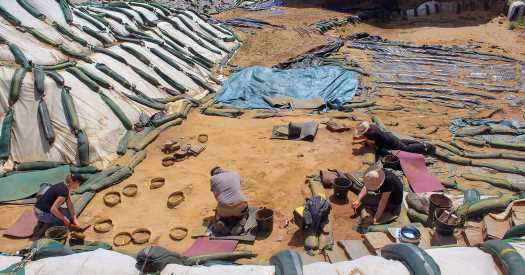A group of Neanderthal children scampered around the Normandy coast in France 80,000 years ago. Their footprints quickly became covered by windblown sand, preserved as ghostly signs of their passage.
The tracks were eventually discovered by archaeologists working at a site called Le Rozel on the country’s northwestern shore. Carefully brushing away layers of sand, the scientists found 257 footprints between 2012 and 2017. The team described the collection in a paper published Monday in the Proceedings of the National Academy of Sciences.
Evidence from Neanderthal fossils and artifacts discovered across Europe and Asia has slowly painted a picture of the culturally and socially complex lives of our closest extinct human relatives. Contrary to long-held beliefs, Neanderthals were not backward cave men. Scientists have found artifacts that suggest they crafted stone tools, made cave art and carried out various rituals, such as burying their dead.
But a few fossils and isolated artifacts don’t tell the whole story.
“It is really difficult to study the composition and size of Neanderthal groups from skeletal remains and stone tools,” said Jeremy Duveau, a graduate student in paleoanthropology at the French National Museum of Natural History, who led the new study.
In the past, researchers have only been able to guess at the sizes of Neanderthal groups. Assumptions were based on observations of modern human hunter-gatherers, the size of the structures that Neanderthals built for shelter or the number of individuals buried at a particular site. But these methods were all indirect and often hotly contested among archaeologists.
The Le Rozel footprints could help provide a more accurate picture of Neanderthals’ group sizes and social lives.
Mr. Duveau and his colleagues estimated that the Le Rozel tracks had been created by 10 to 13 individuals, who likely occupied the site between autumn and spring of some years. Analyzing the size and shape of the footprints confirmed that they were consistent with what scientists know of Neanderthals’ broader foot structure: slightly wider, with a lower arch than the footprints of typical Homo sapiens.
Based on the size of the footprints, the researchers were also able to calculate the heights of the footprint makers. To their surprise, most of the individuals were under four feet tall, indicating they were children and adolescents. (Average Neanderthal adults are thought to have been around 5-foot-6.) Children outnumbered adults by at least 4 to 1, and the smallest print seemed to belong to a two-year-old.
[Like the Science Times page on Facebook. | Sign up for the Science Times newsletter.]
“The reason this finding is surprising is that the number of kids is slightly out of line from what modern hunting and gathering communities are like,” said William Parkinson, the curator of anthropology at the Field Museum of Natural History in Chicago. He added that groups of modern hunter-gatherers typically contain more adults than children.
The number of children in the Le Rozel group also stands out from the handful of Neanderthal burial sites that scientists have found around the world. At the El Sidron cave in Spain and the Krapina archaeological site in Croatia, scientists have found remains of Neanderthal groups that consisted of more adults than children.
“This could speak to variability in Neanderthal groups,” Dr. Parkinson said. “Maybe what we’re looking at is differential practices in who gets buried in specific sites, and those sites don’t represent actual group composition.”
The Le Rozel prints also raise new ideas about Neanderthals’ social lives. Perhaps adult Neanderthals left their children with chaperones while they went off to hunt or work nearby. Or perhaps the adults died young, Mr. Duveau said.
The footprints make Le Rozel a very important site: People can look at the Le Rozel footprints and picture young Neanderthals scampering around a beach several thousand years ago.
“It’s the first time that we can talk about how big a group is in a moment when they were walking around,” Dr. Parkinson said. “It sort of brings to life the past.”
Sites with Neanderthal footprints are extremely rare. Scientists have found just nine other Neanderthal footprints around the world, in Gibraltar, Greece, Romania and France.
But researchers have continued to uncover hundreds more footprints at Le Rozel. And scattered among the tracks are also eight handprints, remains of stone tools and signs of a butchery.
Mr. Duveau and his team have painstakingly photographed and created 3D models of each of their findings. They also made casts of the prints and removed some for better preservation.
A small set of the casts are currently on display at the International Center of Prehistory in Les Eyzies-de-Tayac-Sireuil, France, and at the Canadian Museum of History. Most of the rest are kept in an archive managed by France’s Ministry of Culture, where researchers hope further studies will reveal more about Neanderthals’ behavior and group mobility.
Source: Read Full Article






